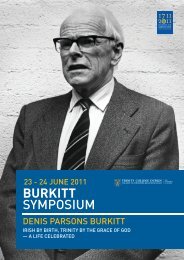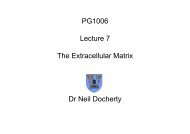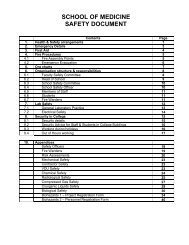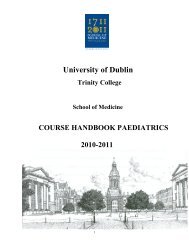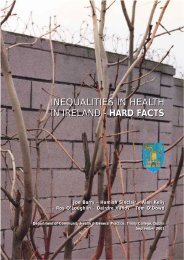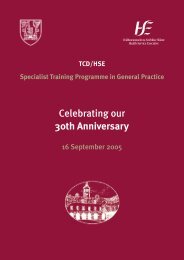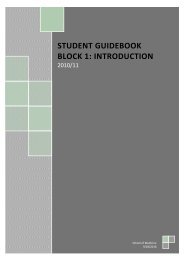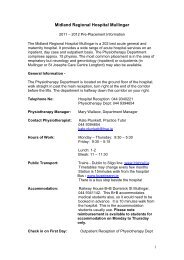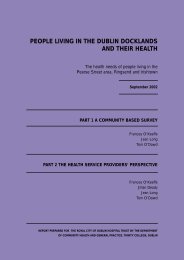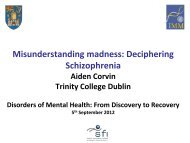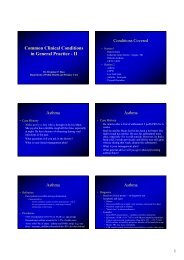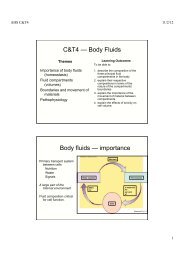year-2-study-guide-2.. - School of Medicine - Trinity College Dublin
year-2-study-guide-2.. - School of Medicine - Trinity College Dublin
year-2-study-guide-2.. - School of Medicine - Trinity College Dublin
Create successful ePaper yourself
Turn your PDF publications into a flip-book with our unique Google optimized e-Paper software.
Course Content<br />
LECTURES<br />
WEEK 1<br />
(Biochemistry) Cell-types in the brain and their functions.<br />
Introduction. Glial cell diversity and specialisation. Neurone-glial cell interdependence.<br />
Organelle transport (anterograde & retrograde). Neurotransmitter diversity & criteria.<br />
(Anatomy) Introduction: CNS development<br />
Ectodermal origin <strong>of</strong> the neural plate, neural folds and neural tube; Formation <strong>of</strong> brain and<br />
spinal cord; Alar and basal plates; Motor and sensory neurons; Rhombencephalon<br />
(myelencephalon and metencephalon), mesencephalon and prosencephalon (diencephalon<br />
and telencephalon); Formation <strong>of</strong> the medulla, pons, midbrain, cerebellum, basal ganglia,<br />
thalamus, hypothalamus, pituitary and the cerebral hemispheres; Development <strong>of</strong> the<br />
ventricular system.<br />
(Physiology) Ionic channels 1<br />
-properties <strong>of</strong> ionic channels, especially Na, Ca K and Cl channels<br />
-involvement <strong>of</strong> voltage gated channels in generation <strong>of</strong> action potential<br />
(Anatomy) Cerebral hemispheres: topography<br />
Meninges; Sulci; Gyri; Frontal, parietal, temporal, occipital and limbic lobes; Inferior aspect <strong>of</strong><br />
brain; Insula; Cortical areas (Brodmann); Primary motor cortex; Premotor cortex;<br />
Supplementary motor area; Primary sensory cortex; Auditory cortex and language areas;<br />
Visual cortex; Association cortex; Commisural, projection and association fibres; Structural<br />
aspects; laminar organisation <strong>of</strong> the cerebral cortex; Isocortex and neocortex.<br />
(Physiology) Ionic channels 2<br />
Ionic channels continued.<br />
(Biochemistry) Neuro-Techniques and Brain Metabolism. Methods for <strong>study</strong>ing<br />
neurotransmission. Synaptosomes, cultured cells and other model systems. Tracing and<br />
identification <strong>of</strong> tracts. Composition, types, bioenergetics, storage and transport, exocitosis.<br />
Synaptic vesicles (SSVs and LDCVs).<br />
(Psychiatry) Brain and Mind- Would this lecture (given by Ian Robertson work as a nice<br />
overview to the whole course? I could send him on details or a slide indicating the areas<br />
represented on the course.<br />
What we know about the interaction between brain processes and mental states. The<br />
interactions between the physical and the mental and between biological and psychological.<br />
(Psychiatry) Cognitive development I<br />
Piaget’s theory as the main theory <strong>of</strong> cognitive development, how theories <strong>of</strong> development<br />
might inform clinical work, Intelligence and its measurement, the concept <strong>of</strong> IQ and its<br />
advantages and limitations.<br />
(Biochemistry) Acetylcholine neurotransmission. NMJ. Docking proteins and evidence from<br />
botilinus and tetanus toxins. Stimulation <strong>of</strong> release by chemical, neurotoxic, ionic and<br />
electrical means. Mechanisms and control <strong>of</strong> release - the role <strong>of</strong> calcium ions and <strong>of</strong><br />
phosphorylation events.<br />
(Anatomy) Ventricles and CSF<br />
Lateral ventricle: Central part, with frontal, occipital and temporal horns; interventricular<br />
foramen; relationship with caudate nucleus, septum pellucidum, corpus callosum, fornix,<br />
thalamus, forceps major, calcar avis, amygdala, hippocampus and tela choroidea. Third<br />
31



